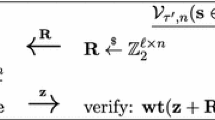Abstract
Authentication codes are used to protect communication against a malicious adversary. In this paper we investigate unconditionally secure multiround authentication schemes. In a multiround scheme a message is authenticated by passing back and forth several codewords between the sender and receiver. We define a multiround authentication model and show how to calculate the probability of a successful attack for this model. We prove the security for a 3-round scheme and give a construction for the 3-round scheme based on Reed-Solomom codes. This construction has a very small key size for even extremely large messages. Furthermore, a secure scheme for an arbitrary number of rounds is given. We give a new upper bound for the keys size of an n-round scheme.
Similar content being viewed by others
References
G.J. Simmons, A survey of Information Authentication, Contemporary Cryptology, The Science of Information Integrity, IEEE Press (1992).
G.J. Simmons, Authentication theory/coding theory, Proceedings ofCRY PTO 3'84, Springer-Verlag, New York, Lecture Notes on Computer Science, 196, (1985) pp. 411-431.
R. Johannesson and A. Sgarro, A strengthening of Simmons’ bound on impersonation, IEEE Trans. on Information Theory, Vol. 37, No.4 (1991) pp. 1181-1185.
E.F. Brickell, A few results in message authentication, Congresus Numerantium, Vol. 43 (1984) pp. 141-154.
G. Kabatianskii, B. Smeets, T. Johansson, On the cardinality of systematic A-codes via error correcting codes, IEEE Trans. on Information Theory, Vol. 42, No.2 (1996) pp. 566-578.
E. Gilbert, F.J. MacWilliams, N. Sloane, Codes Which Detect Deception, Bell System Technical Journal, Vol. 53, No.3 (1974) pp. 405-424.
J.L. Carter, M.N. Wegman, New hash functions and their use in authentication and set equality, J. Computer and System Sci., Vol 22, (1981) pp. 265-279.
D.R. Stinson, Universal hashing and authentication codes, Designs, Codes and Cryptography, Vol. 4, No.4 (1994) pp. 369-380.
J. Bierbrauer, T. Johansson, G. Kabatianskii, B. Smeets, On Families of Hash Functions via Geometric Codes and Concatenation, Proceedings of CRYPTO’ 93, Springer Verlag, New York, Lecture Notes in Computer Science 839, (1993) pp. 331-342.
T. Helleseth, T. Johansson, Universal Hash Functions from Exponential Sums over Finite Fields and Galois Rings, Proceedings of CRYPTO’ 96, Springer Verlag, New York, Lecture Notes in Computer Science 1109 (1996) pp. 31-44.
P. Gemmell, M. Naor, Codes for interactive authentication, Proceedings of CRYPTO’ 93, Springer Verlag, New York, Lecture Notes in Computer Science 773 (1993) pp. 355-367.
C. Gehrmann, Cryptanalysis of the Gemmell and Naor Multiround Authentication Protocol, Proceedings of CRYPTO’ 94, Springer Verlag, New York, Lecture Notes in Computer Science 839 (1994) pp. 121-128.
C. Gehrmann, Secure multiround authentication protocols, Proceedings of Eurocrypt’ 95, Springer Verlag, New York, Lecture Notes in Computer Science 921 (1995) pp. 158-167.
M. Bellare, J. Kilian, and P. Rogaway, The security of cipher block chaining, Proceedings of CRYPTO’ 94, Springer Verlag, New York, Lecture Notes in Computer Science 839 (1994) pp. 341-358.
P. Rogaway, Bucket Hashing and its Application to Fast Message Authentication, Proceedings of CRYPTO’ 95, Springer Verlag, New York, Lecture Notes in Computer Science 963 (1995) pp. 29-42, 1995.
B. den Boer, A simple and key-economical unconditionally secure authentication scheme, Journal fo Computer Security, Vol. 2 (1993) pp. 65-71.
V. Afanassiev, C. Gehrmann, B. Smeets, Low Complexity Polynomial Evaluation for Fast Message Authentication, Proceedings of FSE4, Springer Verlag, New York, Lecture Notes in Computer Science 1267 (1997) pp. 190-204.
T. Johansson, G. Kabatianskii, B. Smeets, On the relation between A-codes and codes correcting independent errors, Proceedings of Eurocrypt’ 93, Springer Verlag, New York, Lecture Notes in Computer Science 765 (1993) pp. 1-11.
T. Johansson, Contribution to Unconditionally Secure Authentication, Ph. D. thesis, Lund, (1994).
I.S. Reed, G. Solomon, Polynomial Codes over certain Finite Fields, J. Soc. Ind. Appl. Math., Vol. 8 (1960) pp. 300-304.
R. Safavi-Naini and L. Tombak, Authentication Codes in Plaintext and Chosen-Content Attacks, Designs, Codes and Cryptography, Vol. 7, No.1/2 (1996) pp. 83-99.
F.J. Mac Williams, N. Sloane The Theory of Error-Correcting Codes, North-Holland, (1977).
M. Atici and D. R. Stinson Universal Hashing and Multiple Authentication, Proceedings of CRYPTO’ 96, Springer Verlag, New York, Lecture Notes in Computer Science 1109 (1996) pp. 16-30.
Author information
Authors and Affiliations
Rights and permissions
About this article
Cite this article
Gehrmann, C. Multiround Unconditionally Secure Authentication. Designs, Codes and Cryptography 15, 67–86 (1998). https://doi.org/10.1023/A:1008277509057
Issue Date:
DOI: https://doi.org/10.1023/A:1008277509057




